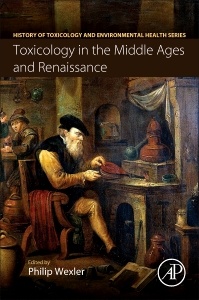Description
Toxicology in the Middle Ages and Renaissance
History of Toxicology and Environmental Health Series
Coordinator: Wexler Philip
Language: English
Subject for Toxicology in the Middle Ages and Renaissance:
Keywords
Affair of the Poisons; Agricola; Albertus Magnus; Alchemy; Alicorn; Alkahest; Amulet; Ancient materia medica; Andrea Bacci; Animal stones; Antidote; Arsenic; Avicenna; Bergsucht; Bezoar; Bites; Borgia; Cantarella; Cosimo I de' Medici; Court testimony; Crime; Criminal magical underworld; Dioscorides; Disease; Egypt; Endogenous concretions; Environmental medicine in the Renaissance; Food poison; Francesco Redi; Gentile da Foligno; Giulia Tofana; Glossopetra; Goa Stone; Greek language; Henri de Mondeville; Herbal poison; History of medicine; History of toxicology; Hunting poisons; Intoxication; Islamic; Jewish; Khutu; Languier; Lapidaries; Lapidary; Lapis lazuli; Magic; Maimonides; Malta; Mammoth; Manosque; Medical alchemy; Medicine; Medieval; Mercuric chloride; Mercury; Michele Mercati; Murder; Musk ox; Narwhal; Natternzungenbaum; Otodus megalodon; Paracelsianism; Paracelsus; Persian; Petrus Christus; Physician education; Physician expertise; Pietro d'Abano; Poison; Poison theories; Poisons; Pope Alexander VI; Post mortem; Rabid dog; Radon daughters; Recipe collecting; Renaissance; Ricettario Fiorentino; Saxony mining; Scorpion; Slow poison; Snake; Spider; Teofania di Adamo; The Chambre Ardente; Toxic metals; Toxicology; Toxin; Unicorn; Universal medicine; Universal solvent; Van Helmont; Venom; Walrus; Work-related lung cancer
Support: Print on demand
Description
/li>Contents
/li>Biography
/li>Comment
/li>
Toxicology in the Middle Ages and Renaissance provides an authoritative and fascinating exploration into the use of toxins and poisons in the Middle Ages and Renaissance. Part of the History of Toxicology and Environmental Health series, this volume is a follow-up, chronologically, to the first two volumes which explored toxicology in antiquity.
The book approximately covers the 1100s through the 1600s, delving into different aspects of toxicology, such as the contributions of scientific scholars of the time, sensational poisoners and poisoning cases, as well as myths. Historical figures, such as the Borgias and Catherine de Medici are discussed. Toxicologists, students, medical researchers, and those interested in the history of science will find insightful and relevant material in this volume.
1. Poison and Its Dose: Paracelsus on Toxicology 2. The Golden Age of Medieval Islamic Toxicology 3. Maimonides’ Book on Poisons and the Protection Against Lethal Drugs 4. Pietro d’Abano, De venenis: Reintroducing Greek Toxicology into Late Medieval Medicine 5. The Case Against the Borgias: Motive, Opportunity, and Means 6. Aqua Tofana 7. Poisons and the Prince: Toxicology and Statecraft at the Medici Grand Ducal Court 8. Georgius Agricola, a Pioneer in the Toxic Hazards of Mining, and His Influence 9. Jan Baptist Van Helmont and the Medical–Alchemical Perspectives of Poison 10. Origin of Myths Related to Curative, Antidotal and Other Medicinal Properties of Animal “Horns in the Middle Ages 11. Animal Stones and the Dark Age of Bezoars 12. Fossil Sharks’ Teeth as Alexipharmics 13. Catherine La Voisin: Poisons and Magic at the Royal Court of Louis XIV 14. A Late Medieval Criminal Prosecution for Poisoning: The Failed Murder Trial of Margarida de Portu (1396) 15. Animal Venoms in the Middle Ages 16. Medical Literature on Poison, c. 1300–1600
Phil recently retired from a long federal career as a Technical Information Specialist at the National Library of Medicine’s (NLM) Toxicology and Environmental Health Information Program, within its Specialized Information Services Division (SIS). His initial position at NLM was as a Fellow of its Associate Program and early work included a brief stint in the Reference Services Section. A recipient of the NLM Regents Award for Scholarly or Technical Achievement and the Distinguished Technical Communication Award of the Washington chapter of the Society for Technical Communication, he was team leader for the development of the ToxLearn online multi-module tutorials, a joint activity with the SOT. Phil had also been project officer for the LactMed file on drugs and lactation, and the IRIS (Integrated Risk Information System) and ITER (International Toxic
- Provides the historical background for understanding modern toxicology
- Illustrates the ways previous civilizations learned to distinguish safe from hazardous substances, how to avoid them, and how to use them against enemies
- Explores the way famous historical figures used toxins




